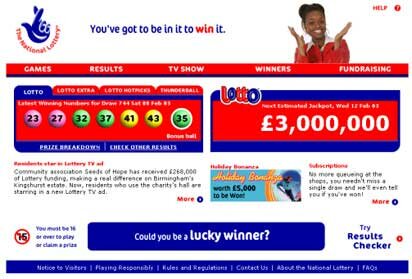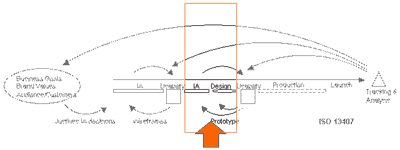|
Site www.national-lottery.co.uk

lotto homepage
Camelot is the operator of the UK National Lottery. Camelot's main objective is to maximise revenue for Good Causes and the Government through lottery games in the most efficient and socially responsible way. This involves creating, marketing and promoting new games, running and developing the lottery infrastructure, providing services for players and winners and working in partnership with retailers.
At present, players can play the lottery via a retailer or by subscription. Camelot plans to offer National Lottery games on the Internet, mobile phones and Interactive TV.
Development overview
The following diagram illustrates the areas of activity of the project.

Challenge
Camelot was very clear about its business goals and strategy regarding its plans for on-line gaming. The Information Architect was appointed to develop the on-line gaming experience, which was structured as follows:
- Review of games section
- Registration process
- Account management
- Subscription process
- On-line gaming process
Solution
Review of games section
The current structure of the website already had a section called 'Games' and users understood this section as a pure information source. The challenge was to promote the new services without confusing the existing audience and so it was decided that merging the two sections was the best option as having two sections called 'Games' and 'Games on-line' would be confusing for the audience. A sitemap that showed the best way to merge the two sections was developed and passed on to web designers for implementation.
Registration process
On-line gaming requires the user to register and open an account with Camelot. Furthermore each user had to deposit a minimum amount of £5 unless one or more lottery tickets worth that amount were purchased in one session. It was therefore important, when creating the wire frame, to concentrate on a user-friendly registration process that explains the steps involved clearly and guides the user on how to deposit money.
Account management
Camelot customers are able to manage their accounts online. Customers can edit their account and profile, add combinations of numbers to their favourites and either deposit or withdraw money to or from their wallet. The Information Architect produces a set of wireframes, which was used to define these processes and identify the technical requirements.
Subscription process
Camelot plans to give customers the option of subscribing online. The Information Architect's task was to develop the subscription process online through in-depth consultation with the client, which included workshops to fully understand the current processing of subscriptions and the implications of the proposed online subscription process. Wire frames were then produced to investigate the best solution for selecting the numbers. These wire frames were also used for user testing to ascertain that the recommended solutions were indeed optimal.
On-line gaming process
Having specified the structure of the games section, wire frames were used to define the processes of playing the lottery online. The wire frames demonstrated how and when users need to register and/or sign in to successfully purchase a lottery ticket on-line.
Some user testing was conducted on the subscription pages, which afforded the Information Architect and the Camelot team deep insight on how users prefer to perform certain tasks online including information on how users prefer to pick their numbers.
The gaming process was formulated from PowerPoint and converted into HyperText Markup Language (html) pages. Actual HTML is best for user testing as the pages are in a browser environment and contain screen elements that are both realistic and semi functional - which is half way along the road to prototypes.
Results
- The structure of the games section was reviewed and recommendations were delivered regarding the integration of new products.
- The processes for purchasing a lottery ticket on-line were defined and wireframes were handed over to designers and back-end developers.
- In addition, requirements for the registration process and account management tasks were defined and documented.
- The on-line subscription process was developed with back-end developers to ensure smooth transition from print to on-line submission.
Return to newsletter
|



